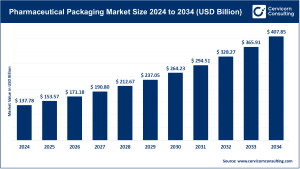Food Packaging Market Overview
The global food packaging market was valued at around USD 417.98 billion in 2025 and is expected to exceed USD 590.28 billion by 2034, registering a CAGR of 5.9% during the forecast period. This market includes all packaging materials, machinery, containers, and related services that facilitate the packaging, protection, transportation, and marketing of food and beverage products. Packaging formats include flexible, rigid, and semi-rigid types, while key materials range from plastics, paper and paperboard, metals, and glass to bio-based alternatives gaining popularity for sustainability.
Major application areas comprise bakery and confectionery, dairy, fruits and vegetables, meat and seafood, sauces and dressings, and other processed foods, with frozen food packaging accounting for the largest share due to its need for durable, moisture-resistant materials.
👉 Get a Free Sample: https://www.cervicornconsulting.com/sample/2764
Key Market Trends
1. Adoption of Green Materials
Sustainability is driving innovation with biodegradable plastics, compostable films, and FSC-certified paperboard. For instance, Hinojosa Packaging Group unveiled Halopack and Sumbox at Conxemar 2025, showcasing recyclable solutions for frozen seafood and other food segments.
2. Rise of Smart Packaging
Manufacturers are integrating QR codes, RFID tags, and augmented reality into packaging to enhance traceability, safety, and consumer engagement. At Interpack 2025, several European companies introduced interactive labels and digital transparency systems for better customer connection.
3. Expansion of Flexible Packaging
Flexible packaging continues to dominate due to its lightweight, space-efficient, and protective properties, making it suitable for snacks, frozen foods, and ready-to-eat meals.
4. Technological Innovations
The adoption of active packaging, featuring freshness indicators and modified atmosphere packaging (MAP), is helping manufacturers extend shelf life and maintain food quality during storage and transit.
Market Drivers
1. Convenience and On-the-Go Consumption
Increasing consumer demand for ready-to-eat and portable food is boosting the need for packaging that ensures freshness, safety, and ease of use. Retailers like Tesco and Sainsbury’s expanded their ready-meal offerings in eco-friendly trays in 2025.
2. Regulatory Pressures on Plastic Reduction
Governments are implementing stringent plastic waste regulations, promoting recyclable and biodegradable alternatives. The UK government, for instance, proposed restrictions on plastic packaging for selected fruits and vegetables.
3. Growth of E-Commerce and Food Delivery
With the rapid rise of online grocery and meal delivery, companies like Ocado and Deliveroo tested recyclable, temperature-resistant packaging solutions in 2025 to preserve food quality during transport.
4. Technological Advancements
Smart packaging facilitates real-time monitoring, traceability, and customer interaction, allowing brands to differentiate their products and build stronger consumer trust.
Impact of Trends and Drivers
The impact of these dynamics varies across market segments:
-
Flexible packaging is expanding rapidly within frozen and convenience foods.
-
Smart packaging sees higher adoption in premium and processed food categories.
-
Sustainable materials are in strong demand in Europe and North America, driven by consumer awareness and regulatory backing.
-
In Asia-Pacific, market growth is supported by urbanization, income growth, and e-commerce expansion.
Challenges and Opportunities
Challenges
-
Elevated production costs for eco-friendly and smart materials.
-
Limited recycling infrastructure in developing regions.
Opportunities
-
Expansion of online food delivery ecosystems.
-
Growing consumer awareness of sustainability.
-
Technological innovation in recyclable, smart, and lightweight packaging designs.
Companies that invest in sustainability and digital innovation are expected to gain a competitive advantage and enhance brand differentiation in the evolving market landscape.
Future Outlook
The food packaging industry is poised for transformation, led by sustainable materials, smart packaging integration, and e-commerce-driven solutions. These advancements will enable companies to address shifting consumer preferences, comply with environmental regulations, and tap into new growth opportunities across global markets.
📩 Contact Us for a Detailed Overview
Explore more insights here: https://www.cervicornconsulting.com/food-packaging-market


